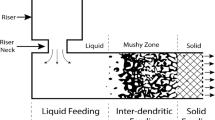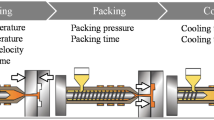Research projects in foreign materials science were analyzed. Specific technological methods for forming ceramic items were examined. The study presents a facility for injection molding of thermoplastic items based on ceramic and metal-ceramic powders developed at Bakul Institute for Superhard Materials of the National Academy of Sciences of Ukraine. The heat transfer process during injection molding of a nozzle and the ball with an axial cylindrical hole, ring, and solid ball formed from ceramic materials based on powders of aluminum nitride, tungsten carbide, and silicon has been computer-modeled. Danger areas of local isothermal concentrations in molds have been identified. It has been established that the cooling time of thermoplastic mass in molds to reach the binder solidification temperature depends on the type of material to be injected. The pattern of the furnace temperature change to provide uniform heating of a cast product at the debinding stage was calculated. A sample of the temperature change patterns calculated during binder sublimation from a ball-shaped product of different sizes was presented. The process of mold filling with thermoplastic mass during injection molding of ceramic items in the form of a ball with a cylindrical hole, ring, solid ball, nozzle, and funnel based on powders of aluminum nitride, tungsten carbides, and silicon has been modeled using computer-assistance tools. Pressure distributions in mold cavities and time of filling with thermoplastic mass were obtained. The optimal location of the injection hole in molds has been determined at which the weld lines length is minimum at the end of the injection. The dependencies of the mold filling time and the weld lines length at different material viscosity values on the product's dimensional parameters have been defined. The experimental part of the injection molding technology was also considered for the aluminum nitride powder nozzle at argon arc welding. The graphs of minimum injection temperature changes have been obtained, at which the defect-free nozzle blanks are formed with changing binder concentration and mass viscosity. The obtained calculated data determine the whole complex of the injection molding technological features, which can be used to produce various shapes of ceramic items.
















Similar content being viewed by others
References
R.M. German, Powder Injection Molding, Metal Powd. Industr. Fed., Princeton (1990), p. 521.
N.V. Novikov, V.V. Ivzhenko, V.A. Popov, A.A. Leshchuk, and G.F. Sarnavskaya, “Equipment for Injection Moulding of Thermosetting Materials Based on Ceramic and Metal-Ceramic Powder,” Powder Metall. Met. Ceram., 43, No. 9–10, 538–545 (2004).
A.N. Oumer, A.M.S. Ali, and O.B. Mamat, “Numerical simulation of fibre orientation in simple injection molding processes,” Int. J. Mech. Mechatron. Eng., 9, Issue 9, 18–24 (2009).
M.G.H.M. Baltussen, M.A. Hulsen, and G.W.M. Peters, “Numerical simulation of the fountain flow instability in injection molding,” J. Non-Newtonian Fluid Mech., 165, 631–640 (2010).
V. Onbattuvelli, S. Laddha, S.-J. Park, J.P. De Souza, and S.V. Atre, “Powder injection molding of SiC for thermal management,” Technol. Metal. Mater. Miner., 9, Issue 2, 123–131 (2012).
V.V. Bilovol, Mould filling Simulations during Powder Injection Molding, PhD Thesis, Delft Univ. Technol., Delft (2003), p. 136.
D.E. Sidorov, S.O. Pristailov, A.A. Lyzogubenko, and M.S. Kushnir, “Injection molding of a product based on secondary polystyrene, Visnyk NTUU “Kyiv Polytechnic Institute,” Chemical Engineering, Ecology, and Resource Conservation, No. 1, 33–36 (2010).
O.G. Frolova, L.N. Tkachenko, A.L. Maksimenko, and M.B. Stern, “Investigation of slip flow in computer modeling of injection molding technology,” Mathematical Models and Computational Experiment in Materials Science, Issue 9 (2007), 31–34.
N.V. Novikov, V.V. Ivzhenko, A.A. Leschuk, V.A. Popov, G.F. Sarnavskaya, and A.P. Antonyuk, “Experimental researches and modeling of injection molding for products of complex forms from technical ceramics,” Superhard Mater., No. 5, 3–19 (2004).
A.A. Leschuk, T.A. Tsysar, and V.V. Ivzhenko, “Computer modeling of heat transfer processes during injection molding of products of complex shapes,” Superhard Mater., No. 2, 34–43 (2009).
V.C. Chirkin, Thermophysical Properties of Materials of the Nuclear Industry [in Russian], Atomizdat, Moscow (1968), p. 484.
Tables of Physical Values: Handbook, I.K. Kikoin (Ed.) [in Russin], Atomizdat, Moscow (1976), 1008 p.
V.I. Tumanov, Properties of Tungsten–Cobalt Carbide Alloys: Handbook [in Russian], Metallurgiya, Moscow (1971), p. 96.
Author information
Authors and Affiliations
Corresponding author
Additional information
Translated from Poroshkova Metallurgiya, Vol. 60, Nos. 3–4 (538), pp. 28–45, 2021.
Rights and permissions
About this article
Cite this article
Psiarnetska, T., Kirkova, O., Leshchuk, O. et al. Development of Ceramic Items Injection Moulding Technology Using Computer Modeling. Powder Metall Met Ceram 60, 150–163 (2021). https://doi.org/10.1007/s11106-021-00223-3
Received:
Published:
Issue Date:
DOI: https://doi.org/10.1007/s11106-021-00223-3




